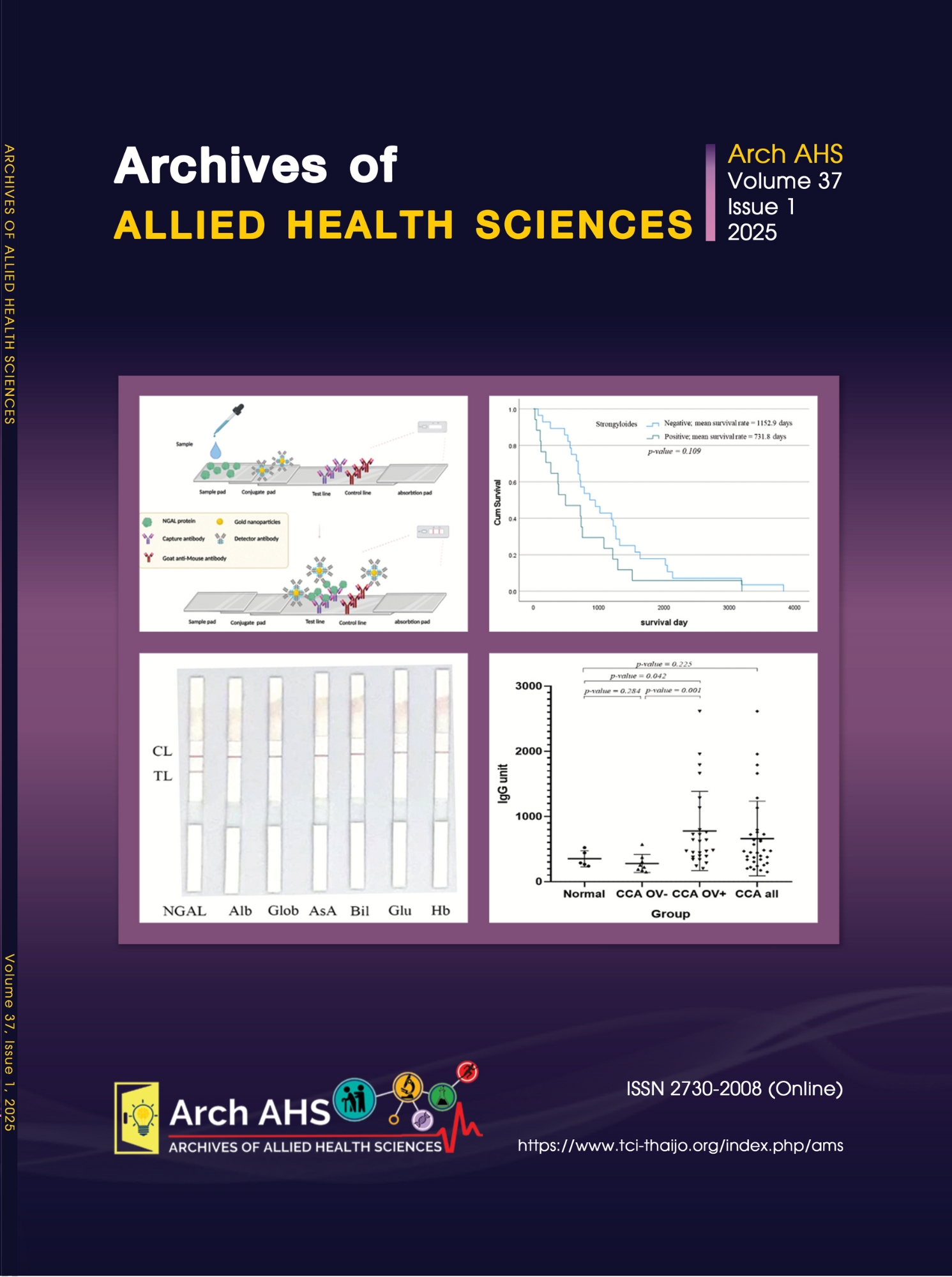Association of musculoskeletal pain patterns of college students due to the usage of mobile phone
Main Article Content
Abstract
Mobile phones have become widely used as online learning platforms, which provide students with flexibility to access content at a time and in a place that is convenient for them. Due to the ubiquity of mobile phones, they may be used in a variety of positions that could expose their musculoskeletal system. This study aimed to investigate if there is an association between musculoskeletal pain patterns due to the usage of mobile phones. Cross-sectional study was conducted on 778 students with individual mobile phones through self-made questionnaire that consisted of general information and a standardized Nordic Musculoskeletal Questionnaire. The study revealed that the predominant site of pain patterns was the neck (64.27%), lower back (66.2%), and upper back area (54.37%). Duration of 19- 24 hours (93.57%) and sitting position (58.87%) was associated with a higher frequency of mobile phone use. Regarding patterns of pain, fatigue (26.74%) type was predominant. There was statistically significant difference found between specific mobile phone usage behaviors and patterns of musculoskeletal pain. More specifically, study sessions were linked to upper back pain (p-value = 0.049), hips/thigh (p-value = 0.021), and neck pain (p-value = 0.021). Social media streaming was linked to neck pain (p-value = 0.041) and ankle pain (p-value= 0.035). Leisure activities and video games were linked to lower back pain (p-value = 0.048), whereas how a mobile phone is held related to wrist pain (p-value = 0.005). The posture adopted and duration of usage are strong determinants of musculoskeletal pain patterns. The study's findings indicate a strong link between musculoskeletal pain in the neck, upper back, and hips and mobile phone usage, particularly in terms of duration and posture. Understanding this relationship can help raise awareness among students, guide prevention, diagnosis, and treatment strategies.
Article Details

This work is licensed under a Creative Commons Attribution-NonCommercial-NoDerivatives 4.0 International License.
References
Al-Hadidi F, Bsisu I, AlRyalat SA, Al-Zu’bi B, Bsisu R, Hamdan M, et al. Association between mobile phone use and neck pain in university students: A cross-sectional study using numeric rating scale for evaluation of neck pain. PloS one 2019; 14(5): e0217231.
Yorulmaz DS, Karadeniz H, Duran S, Çelik İ. Determining the musculoskeletal problems of academicians who transitioned to distance education during the COVID-19 pandemic. Work 2022; 71(3): 493-503.
Elghomati A, Korhan O, Sekeroglu B, Dogruyol K. Short-term impacts of mobile touch-screen device use on musculoskeletal disorders during Covid-19 pandemic: risk assessment modelling and verification. SAJIE 2022; 33(2): 62-77.
Daniyal M, Javaid SF, Hassan A, Khan MA. The relationship between cellphone usage on the physical and mental wellbeing of university students: A cross-sectional study. Int J Environ Res Public Health 2022; 19(15): 9352.
Odole A, Olutoge DA, Awosoga O, Mbada CE, Fatoye C, Oyewole O, Oladele RI, Fatoye FA, Akinpelu AO. Musculoskeletal pain and postural abnormalities among smartphoneusing digital natives. J Musculoskelet Disord Treat 2020; 6: 1-12.
Ngamkham S, Holden JE, Wilkie DJ. Differences in pain location, intensity, and quality by pain pattern in outpatients with cancer. Cancer Nurs 2011; 34(3):228-37.
Mersal FA, Negm LM, Fawzy MS, Rajennal AT, Alanazi RS, Alanazi LO. Effect of Mobile Phone Use on Musculoskeletal Complaints: Insights From Nursing Students at Northern Border University, Arar, Saudi Arabia. Cureus 2024; 16(3): e57181.
Woo EH, White P, Lai CW. Musculoskeletal impact of the use of various types of electronic devices on university students in Hong Kong: An evaluation by means of self-reported questionnaire. Man Ther 2016; 26: 47-53.
Alotaibi MS, Fox M, Coman R, Ratan ZA, Hosseinzadeh H. Smartphone addiction prevalence and its association on academic performance, physical health, and mental well-being among university students in Umm Al-Qura University (UQU), Saudi Arabia. Int J Environ Res Public Health 2022; 19(6): 3710.
Kuorinka I, Jonsson B, Kilbom A, Vinterberg H, Biering-Sørensen F, Andersson G, Jørgensen K. Standardised Nordic questionnaires for the analysis of musculoskeletal symptoms. Appl Ergon 1987;18(3): 233-7.
Melzack R. The McGill Pain Questionnaire: major properties and scoring methods. pain 1975; 1(3): 277-99.
McCaffery M. Pain, clinical manual for nursing practice. Mosby-Year Book. 1989.
McHugh ML. The chi-square test of independence. Biochem Med 2013; 23(2): 143-9.
Mustafaoğlu R, Zirek E, Yasacı Z, Özdinçler AR. The negative effects of digital technology usage on children’s development and health. Addicta 2018; 5(2): 13-21.
Zirek E, Mustafaoglu R, Yasaci Z, Griffiths MD. A systematic review of musculoskeletal complaints, symptoms, and pathologies related to mobile phone usage. MSKSP 2020; 49:102196.
Yao JP, Sundar V, Ramalingam V. Predictors of mobile video gaming on musculoskeletal pain among university students in selangor, Malaysia. Rev Pesqui em Fisioter 2021; 11(3): 518-27.


